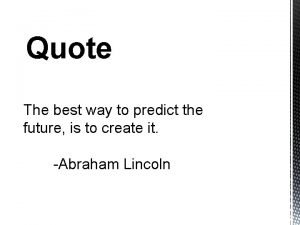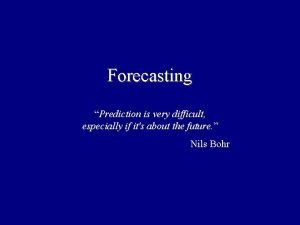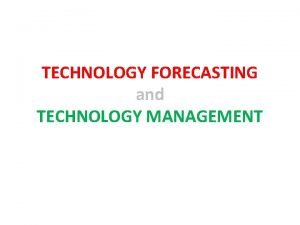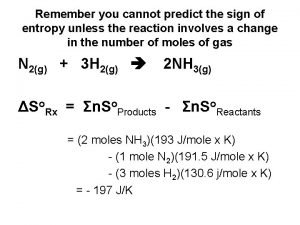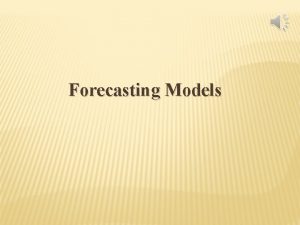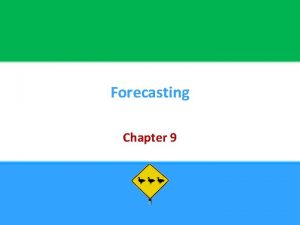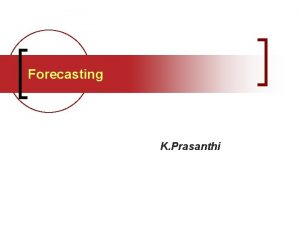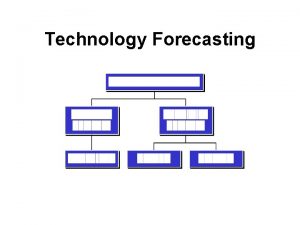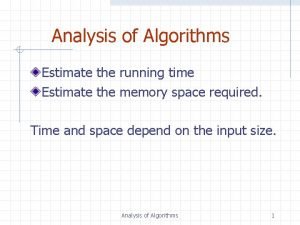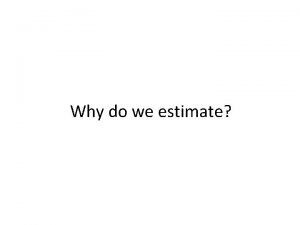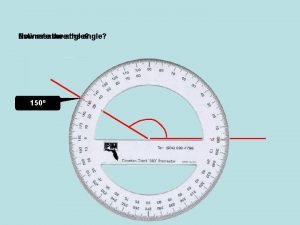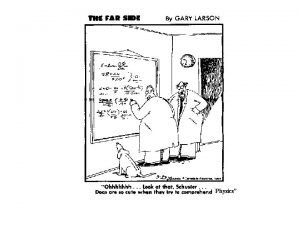Technology Forecasting Forecasting predict or estimate a future

















- Slides: 17

Technology Forecasting

Forecasting • predict or estimate a future event or trend. • "rain is forecast for Lahore“ The use of historic data to determine the direction of future trends. Forecasting is used by companies to determine how to allocate their budgets for an upcoming period of time. This is typically based on demand for the goods and services it offers, compared to the cost of producing them. Investors utilize forecasting to determine if events affecting a company, such as sales expectations, will increase or decrease the price of shares in that company. Forecasting also provides an important benchmark for firms which have a long-term perspective of operations.

Technology Forecasting (1. . ) • Technology Forecasting, in general, applies to all purposeful and systematic attempts to anticipate and understand the potential direction, rate, characteristics, and effects of technological change, especially invention, innovation, adoption, and use. One possible analogy for TF is weather forecasting: Though it is imperfect analogy, TF enables better plans and decisions.

Technology Forecasting (2. . ) • A good forecast can help maximize gain and minimize loss from future conditions. Additionally, TF is no more avoidable than is weather forecasting. All people implicitly forecast the weather by their choice of whether to wear a raincoat, carry an umbrella, and so on. Any individual, organization, or nation that can be affected by technological change inevitably engages in forecasting technology with every decision that allocates resources to particular purposes.

THE NEED FOR TF Technology forecast or Analyses of emerging technologies and their implications inform critical choices ranging from the multinational level (e. g. , the European Union) to the individual organization (e. g. , a company).

THE NEED FOR TF (Large companies) • Prioritize R&D, • Plan new product development, • Make strategic decisions on technology licensing, joint ventures, and so forth.

THE NEED FOR TF(Small companies) • To forecast adoption or diffusion of innovations • To forecast rate of response to advertising can be measured

FUTURE ORIENTED TECHNOLOGY ANALYSIS (FTA) Some overlapping forms of technology forecast are: • Technology monitoring, technology watch, technology alerts (gathering and interpreting information) • Technical intelligence and competitive intelligence (converting that information into usable intelligence) • Technology forecasting (anticipating the direction and pace of changes)

FUTURE ORIENTED TECHNOLOGY ANALYSIS (FTA) • Technology road-mapping (relating anticipated advances in technologies and products to generate plans) • Technology assessment, and forms of impact assessment, including strategic environmental assessment (anticipating the unintended, indirect, and delayed effects of technological changes) • Technology foresight, also national and regional foresight (effecting development strategy, often involving participatory mechanisms)

TM Forecasting Methods • There are hundreds of TF Methods, which can be fit into 9 families: Expert Opinion, Trend Analysis, Monitoring & Intelligence, Modeling & Simulation, Scenarios, Statistical, Descriptive, Creativity, and Valuing/Decision/Economics • We will study a few of them.

EXPERT OPINION • Expert Opinion methods include forecasting or understanding technological development via intensive consultation with subject matter experts. The most popular method in this family is the Delphi Method. This method combines expert opinions concerning the likelihood of realizing the proposed technology as well as expert opinions concerning the expected development time into a single position.

TREND ANALYSIS • Trend analysis involves prediction via the continuation of quantitative historical data into the future. Trend analysis is a broad term that encompasses economic forecasting models and techniques such as regression, exponential smoothing, and growth curve fitting. A technology usually has a life cycle composed of several distinct stages. The stages typically include an initial adoption stage, a growth stage, a maturity stage and a declining final stage. Growth curve forecasting is based on the parameter estimation of a technology's life cycle curve. The growth curve forecasting method is helpful in estimating the upper limit of the level of technology growth or decline at each stage of the life cycle. This method of forecasting is also helpful in predicting when the technology will reach a particular life cycle stage.

MONITORING AND INTELLIGENCE METHODS • Monitoring, Environmental Scanning and Technology Watch, are suitable for making one aware of changes on the horizon that could impact the penetration or acceptance of the technologies in the marketplace. Environmental scanning can be thought of as the central input to future research. ” However, the output is too general to support a specific decision. “The objective of a monitoring system is simply to find early indications of possibly important future developments to gain as much lead-time as possible “.

STATISTICAL METHODS • In the Statistical Methods family, the most popular methods is Correlation Analysis. Correlation analysis forecasts the development patterns of a new technology when the development patterns of the new technology are similar to those of existing technologies. Use of this method presupposes that data regarding the development patterns of the existing technologies are available.

CHOOSING A FORECASTING METHOD • A large number of methods have evolved for TF, but the quality of forecasts greatly depends on proper selection and application of appropriate methods. The application demands that the technique used need to be time-, space- and technology-specific. Yet, there is little research done on matching the TF methods techniques to a particular technology.

A study on choosing forecast methods Factors Scaling parameter 1 Scaling Parameter 2 Scaling parameter data availability Small/low degree of data validity medium/moderate similarity between proposed technology and existing technologies Large/high

• Given a small amount of low or medium validity data, and no similarity between proposed technology and existing technologies, a reasonable choice is a method based on information obtained from a panel of experts (i. e. , Delphi method or interviews). • Given a moderate to large amount of medium to high validity data and a high degree of similarity between proposed technology and existing technologies, they propose using correlation analysis. • When there is medium or large amount of high validity data, trend analysis is the most appropriate method.
 Future perfect simple and future continuous
Future perfect simple and future continuous Future continuous and future perfect
Future continuous and future perfect Lincoln the best way to predict the future is to create it
Lincoln the best way to predict the future is to create it Forecasting is difficult especially about the future
Forecasting is difficult especially about the future Technology life cycle
Technology life cycle Technological process definition
Technological process definition Perfect future
Perfect future Tense chart for class 3
Tense chart for class 3 Future continuous and future perfect
Future continuous and future perfect Future nurse future midwife
Future nurse future midwife Future continuous and present continuous
Future continuous and present continuous Present progressive of plan
Present progressive of plan Future continuous and future perfect
Future continuous and future perfect Future plans and finished future actions
Future plans and finished future actions Future perfect x
Future perfect x Kondicional engleski
Kondicional engleski C2h2 shape
C2h2 shape δhsys
δhsys


